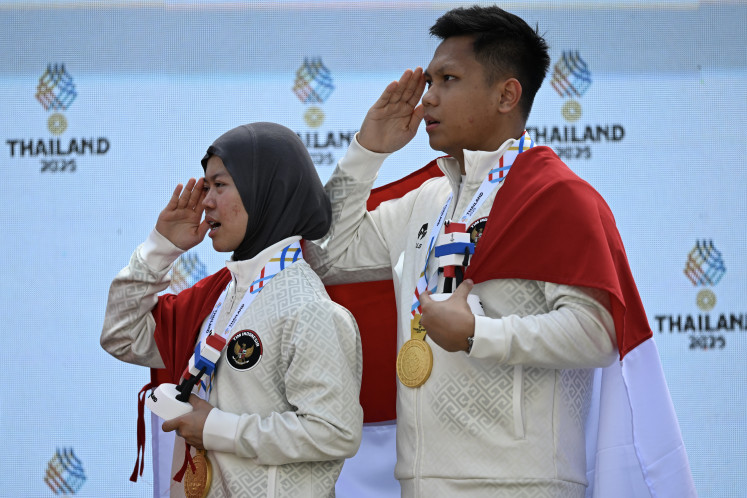Popular Reads
Top Results
Can't find what you're looking for?
View all search resultsPopular Reads
Top Results
Can't find what you're looking for?
View all search resultsKampung Laweyan develops green eco batik
Cultural heritage: Residents in Kampung Batik Laweyan, Surakarta, Central Java, have continued to preserve their old tradition as batik manufacturers
Change text size
Gift Premium Articles
to Anyone
 Cultural heritage: Residents in Kampung Batik Laweyan, Surakarta, Central Java, have continued to preserve their old tradition as batik manufacturers.(thejakartapost.com/Ganug Nugroho Adi)" border="0" height="341" width="512">Cultural heritage: Residents in Kampung Batik Laweyan, Surakarta, Central Java, have continued to preserve their old tradition as batik manufacturers.(thejakartapost.com/Ganug Nugroho Adi)
Cultural heritage: Residents in Kampung Batik Laweyan, Surakarta, Central Java, have continued to preserve their old tradition as batik manufacturers.(thejakartapost.com/Ganug Nugroho Adi)" border="0" height="341" width="512">Cultural heritage: Residents in Kampung Batik Laweyan, Surakarta, Central Java, have continued to preserve their old tradition as batik manufacturers.(thejakartapost.com/Ganug Nugroho Adi)Kampung Batik Laweyan, a long-standing center of batik products in Surakarta, Central Java, will develop a cleaner manufacturing process called âgreen eco batikâ, which aims to reduce river pollution and to support Surakartaâs bid as an Eco Cultural City.
âHouse-scale batik industrial players in Surakarta have used many dangerous chemical-based coloring agents in their batik manufacturing, which has accelerated the progression of environmental pollution, especially in rivers,â Kampoeng Batik Laweyan Development Forum chairman, Alpha Fabela Priyamono, said in Surakarta on Wednesday.
âKampung Laweyan has pioneered the use of natural dye, which is environmentally friendly,â he went on.
Alpha admitted that the use of natural dye in producing batik had several advantages and weaknesses. Naturally dyed batik products usually had less vibrant colors compared to products that used synthetic coloring agents, he added. That was why naturally colored batik were less attractive to consumers. In fact, dyeing with natural products was much more cost efficient than using chemical-based coloring agents.
âKampung Batik Laweyan is working together with several universities in Surakarta to develop natural batik coloring agents that will not allow the batik products to be easy discolored. We want our batik products to be very much in demand without having to neglect environmental aspects,â said Alpha.
He said green eco batik was designed by considering three aspects, one of which was to increase people's awareness of the importance of environment conservation. âAmong the initiatives proposed in this stage includes the acceleration of the reforestation movement by cultivating forests of natural dye producing plants,â said Alpha.
In the second stage, the expert said, green eco batik called for environmentally friendly human settlements. âThis includes a safe waste management, in which all batik production waste would be first processed so that it would not contaminate rivers,â said Alpha, which mentioned an environmentally friendly business management as the third aspect.
span class="caption">Cultural heritage: Residents in Kampung Batik Laweyan, Surakarta, Central Java, have continued to preserve their old tradition as batik manufacturers.(thejakartapost.com/Ganug Nugroho Adi) Kampung Batik Laweyan, a long-standing center of batik products in Surakarta, Central Java, will develop a cleaner manufacturing process called 'green eco batik', which aims to reduce river pollution and to support Surakarta's bid as an Eco Cultural City. 'House-scale batik industrial players in Surakarta have used many dangerous chemical-based coloring agents in their batik manufacturing, which has accelerated the progression of environmental pollution, especially in rivers,' Kampoeng Batik Laweyan Development Forum chairman, Alpha Fabela Priyamono, said in Surakarta on Wednesday. 'Kampung Laweyan has pioneered the use of natural dye, which is environmentally friendly,' he went on. Alpha admitted that the use of natural dye in producing batik had several advantages and weaknesses. Naturally dyed batik products usually had less vibrant colors compared to products that used synthetic coloring agents, he added. That was why naturally colored batik were less attractive to consumers. In fact, dyeing with natural products was much more cost efficient than using chemical-based coloring agents. 'Kampung Batik Laweyan is working together with several universities in Surakarta to develop natural batik coloring agents that will not allow the batik products to be easy discolored. We want our batik products to be very much in demand without having to neglect environmental aspects,' said Alpha. He said green eco batik was designed by considering three aspects, one of which was to increase people's awareness of the importance of environment conservation. 'Among the initiatives proposed in this stage includes the acceleration of the reforestation movement by cultivating forests of natural dye producing plants,' said Alpha. In the second stage, the expert said, green eco batik called for environmentally friendly human settlements. 'This includes a safe waste management, in which all batik production waste would be first processed so that it would not contaminate rivers,' said Alpha, which mentioned an environmentally friendly business management as the third aspect. Batik village: A Laweyan resident bikes across a monument in Kampung Batik Laweyan, an area which has been long known as the center of batik products in Surakarta, Central Java. (thejakartapost.com/Ganug Nugroho Adi) Separately, a batik producer in Kampung Laweyan, Gunawan Nizar, said that in the last several years, a number of batik houses in Laweyan had used natural dye in their batik coloring process. Although most of consumers still chose batik products with chemical-based coloring agents, he said, naturally dyed batik had its own consumers. 'The consumers of naturally colored batik account 20 percent of the total. We have continued to create green eco batik products so that waste from our batik industry will not damage our environment,' said Gunawan. He said a variety of plants could become the sources of natural colors, such as brown from coconut fiber or tea leaves, yellowish red from cinnamon, yellow from turmeric, blue from indigo leaves and reddish brown from mango peels. 'We want Laweyan to continue to develop from its batik products, for that reason we developed green eco batik, which is much more environmentally friendly,' said Gunawan. (ebf)
C
Your Opinion Matters
Share your experiences, suggestions, and any issues you've encountered on The Jakarta Post. We're here to listen.
Thank You
Thank you for sharing your thoughts. We appreciate your feedback.
Share options
Quickly share this news with your network—keep everyone informed with just a single click!
Gift Premium Articles
to Anyone
Share the best of The Jakarta Post with friends, family, or colleagues. As a subscriber, you can gift 3 to 5 articles each month that anyone can read—no subscription needed!
Continue in the app
Get the best experience—faster access, exclusive features, and a seamless way to stay updated.









